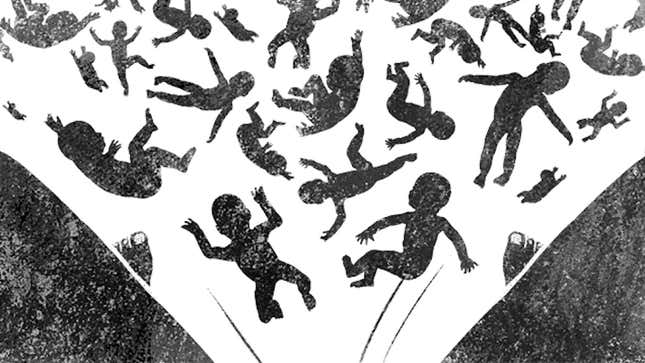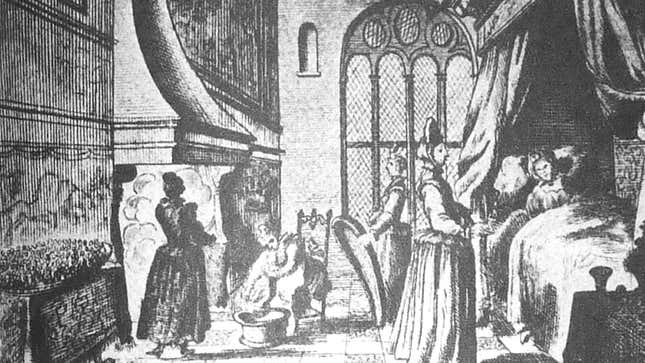The Legend of Countess Margaret, Who Birthed 365 Mouse-Sized Children
Latest

Here is how the story goes: One day, the Countess Margaret of Henneberg met a poor woman who said she was carrying twins. The countess was confounded by the prospect of birthing two children at the same time. She told the poor woman that the only way twins were possible was if they had two different fathers. Outraged, the poor woman cursed the countess, declaring that she would have as many children as there are days in a year.
On Good Friday in 1276, the countess gave birth to 365 children. The children were as small as mice. Legend holds that half the children were girls and half were boys. The boys were baptized as Jan, the girls baptized as Elizabeth. The sex of the odd number child was debated a lot in the seventeenth century. Some theologians decided that child was a hermaphrodite, just to make things even. Regardless, all those tiny children died, and so did their mother.
There are different variations on the story. In one version the countess insults a woman with quadruplets. In another, she insults a woman with twins, making the father of the twins believe that his wife has cuckolded him; he places his wife in jail until the countess gives birth to her 365 children, proving his beloved’s innocence.
But all the stories follow the same pattern: A haughty rich woman insults the motherhood of a poor woman, and as a result, is cursed with children—365 children, all tiny fingerling babies, boys and girls, who die and take their mother with them.
There is an engraving of the scene of Margaret’s miraculous birth by Pieter Kaerius. It depicts a busy bedchamber where Margaret lies in the canopied bed in the right-hand corner, attended to by a midwife. In the foreground other women boil water and stand around, busily ministering the tasks of birth. You might miss it, but in the far left corner, on top of a table is a basin, on top of which 365 little bodies stand unnoticed and unattended to by anyone else in the picture. When I first saw those manifold babies just standing there, I laughed. The absurdity is remarkable. Does no one care about these little babies? Are there so many that they can’t be fully seen? Is it better just to dip them in holy water and turn away?

The legend, of course, is dubious. But Margaret of Henneberg was a real person. Born in 1234, she was married to the Count Herman von Henneberg. She had two children who survived into adulthood, a son, Poppo and a daughter, Jutta. And she did die on Good Friday in 1276 at the family castle in Loosduinen, a small village in the Netherlands.
The first mention of Margaret’s many children is in a late fourteenth-century document that states simply, “During Easter, Countess Margaret of Henneberg gave birth to 364 sons and daughters and died quietly, together with them.” From there, the story grows until it reaches an apex in the early seventeenth century. Childless women would travel to the Loosduinen Abbey and wash their hands in the basin that allegedly baptized all 365 babies. Of course, the basin wasn’t actually the real basin, if there ever was one, But in matters of faith and miracles, proximity is more important than precision. And Margaret’s curse would be their blessing.
Some sixteenth-century writers alleged that one of Margaret’s children was preserved as a curiosity. The child was kept in the Kunst-kammer, the large cabinet of curiosities owned by King Frederick III. Mathies Skaanlunct saw the child, preserved in a glass bottle, hanging from a golden chain. He described it as black with small white nails and as long as one joint of a finger. The author Jan Bondeson surmises that the child in the Kunst-kammer must have really been the product of an abortion and passed off as one of Margaret’s cursed children.
The infant in the bottle was lost in the 1820s, after the Kunst-kammer was dissolved by the government, and legend of Margaret of Henneberg fell out of popularity in the seventeenth century. One of the doctors who gave credence to the story of Margaret of Henneberg, John Maubray, was discredited after his involvement with the scandal of Mary of Toft: the peasant woman who claimed to be giving birth to rabbits, or more specifically rabbit bits—a leg here and piece of lung there. In reality, she was just sticking dead rabbit parts into her vagina and faking labor. Maubray believed Mary of Toft. Yet, when other less credulous doctors investigated the feces of the dead rabbits pulled from Mary’s birth canal, they saw pieces of hay and straw, proof of her ruse. The jig was up, the doctors who gave credence to Mary’s scam were mocked, Maubray included.
-

-

-

-

-

-

-

-

-

-

-

-

-

-

-

-

-

-

-

-

-

-

-

-

-

-

-

-

-

-

-

-

-

-

-

-

-

-

-

-







































